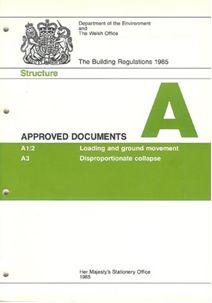STRUCTURE
| The Building Regulations require, in broad terms, that the structure must safely sustain and transfer loads to foundations without undue deformation. In addition the resultant effects on soils below foundations must not impair the stability and serviceability of any part of the building or adjacent structure. The BUILDING DESIGNER should carefully assess structural adequacy and compatibility of all structural elements, and seek professional advice if considered appropriate. This should ensure an early approval to Part A is achieved. In the case of certain traditionally constructed residential buildings not exceeding 3 storeys in height and small domestic buildings/extensions, Approved Document A provides advice in respect of sizes and construction of elements of structure namely: |  |
Timber Roofs/Floor - Floor joists, ceiling joists, common rafters, purlins, binders and
flat roof joists.
Walls/Chimneys - External and internal loadbearing walls including requirements for buttressing.
Foundations - Concrete strip footings based on known suitable ground conditions.
However, for elements of structure and buildings outside the scope of this document, it is recommended that professional advice is sought so that separate submission of structural calculations/plans can be made, especially in respect of the following:
- Timber trussed rafters including Iayout / bracing plans.
- Reinforced concrete flooring systems including layout plans.
- Structural beams/stanchions and frameworks constructed in steel, reinforced concrete, timber, masonry, or other structural material.
- Foundations where adverse ground conditions exist, including close proximity of trees in clay soils.
- Lightweight or unusually shaped buildings that need to be carefully assessed under wind conditions.
- Buildings other than domestic / residential.
- Loft conversions.
This advice only very briefly outlines issues to be considered. Should you wish to discuss any particular proposal, prior to submission of application, please contact Building Control.
Page last updated on: 22/08/2012





